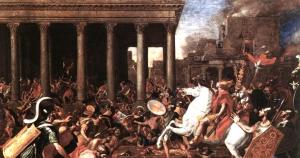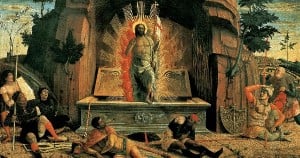 Peter Leithart’s latest book, “Defending Constantine,” should, in my opinion, be considered THE Christian Book of the Year. “DefendingConstantine” is a stunning work of scholarship on a closely related collection of issues that are among the most important in Christianity: the life ofConstantine, the meaning of Constantinianism, and the radical transformation of the world that took place while he was Emperor. Leithart’s work is especially impressive because he has taken on a host of scholars who have so thoroughly denigrated Constantine and “Constantinianism” that it is a truism among most Christians that Constantine was bad for the church and still is. In this scholarly contest, Leithart clearly has proven himself to be the more careful and insightful scholar. It is a work that particularly appeals to me as an Anglican priest, school teacher, and professor of Religious Studies, but it should also be read by every thinking Christian. Despite the lofty themes Leithart tackles, he writes in wonderfully clear English prose.
Peter Leithart’s latest book, “Defending Constantine,” should, in my opinion, be considered THE Christian Book of the Year. “DefendingConstantine” is a stunning work of scholarship on a closely related collection of issues that are among the most important in Christianity: the life ofConstantine, the meaning of Constantinianism, and the radical transformation of the world that took place while he was Emperor. Leithart’s work is especially impressive because he has taken on a host of scholars who have so thoroughly denigrated Constantine and “Constantinianism” that it is a truism among most Christians that Constantine was bad for the church and still is. In this scholarly contest, Leithart clearly has proven himself to be the more careful and insightful scholar. It is a work that particularly appeals to me as an Anglican priest, school teacher, and professor of Religious Studies, but it should also be read by every thinking Christian. Despite the lofty themes Leithart tackles, he writes in wonderfully clear English prose.
If you read one book on Christian history, Christianity and politics, or Christianity and culture this – this book should be the one: it’s THAT good! Don’t let the academic topic of the book fool you: this book has radical implications for every thinking Christian and every church.
“Constantine,” as Leithart reminds us, “has been a whipping boy for a long time, and still is today.” His name is identified with tyranny, anti-Semitism, hypocrisy, apostasy, and heresy. While experts in the field of early Christianity now believe thatConstantinewas a genuine Christian who earnestly tried to apply his faith to his role as Emperor, many other scholars and laymen incorrectly continue to claim otherwise.
In “Defending Constantine,” Leithart audaciously sets out to redeem the reputation of both Constantine and Constantinianism. In both of these tasks, Leithart succeeds admirably. He defines his tasks, more specifically, as being four-fold: to write a life ofConstantine, to rebut the popular caricatures ofConstantine, to redeem the notion of Constantianism, and to demonstrate thatConstantineprovides a model for Christian political practice. It is safe to say that anyone who succeeds to a large degree in these tasks has written a magisterial work. “DefendingConstantine” is just such a work.
Leithart’s history ofConstantineis good, but the real virtuoso nature of the book begins with his discussion of whether or notConstantinewas a genuine Christian or not. Leithart’s unequivocal (and correct) answer is “Yes.” One of the reasons we misunderstandConstantineis that we import our own cultural and historical expectations intoConstantineand his time. This is an important and recurring theme throughout “Defending Constantine.” In this case, false views of the way conversion really works have led some to deny thatConstantinewas ever a Christian. But Leithart demonstrates howConstantineconstantly appeals in his writings to the Christian God who is the heavenly Judge and who, in history, opposes those how oppose Him. Constantinealso demonstrated a genuine and sustained desire to protect the Church – not from political motivations (although they were likely also present) – but from a genuine desire to see the Church remain pure and united.
Another common damnation ofConstantineis based on the notion that he meddled terribly in ecclesiastical matters and acted, apart from the bishops, as the defender of Christian orthodoxy. Once again, Leithart has done his homework and dramatically, though graciously, dismantlesConstantine’s critics. There is no evidence, contrary to assertions by scholars such as Burckhardt and Carroll, thatConstantineever acted as the final authority in church matters. In dealing with the Donatist controversy,Constantinedeflected responsibility to the bishops assembled inRome. Constantinerefused to be seated at the Council of Nicea until he was invited by the bishops. It’s true that he facilitated the work of the Church’s councils by calling them and providing venues, but these and the legal recognition of the conciliar decisions were unavoidable in the political and cultural situation of the time. Constantinenot only did not dominate the discussions at Nicea: he also did not formulate the final creed nor sign off on it.
Leithart’s discussion of Constantianism is also excellent. He defines it as “a theology and ecclesial practice that took form when the church assumed a dominant position in Roman society. Constantianism is “the wedding of power to piety, the notion that the empire or state, the ruler of civil government rather than the church, is the primary bearer of meaning in history.” Leithart reserves his most withering and sustained attack for the Anabaptist theologian, John Howard Yoder, on this point. He shows that Yoder misrepresents the facts and has an axe to grind that comes from his presupposition as an Anabaptist that the church had been in a state of apostasy from the fourth to seventeenth centuries.
If this popular hypothesis were true, we would expect to see dramatic evidence of decline in the lives of Christians and their godly effect on Roman culture. But the opposite is true. In the first place, the bishops refused to be reduced to mere chaplains of the Empire. Second, it was at the instigation ofConstantinethat the gladiatorial shows and other immoral public entertainments were reduced and eventually abolished. Constantine’s legislation looks very much like the kind of legislation Christians should desire the civil magistrates to enact. Constantineremoved previous Roman penalties against the celibate and the childless. He extended the rights of women, removing deprivations such as loss of property and double standards for divorce. He discouraged sex with slaves and was the first in Roman history to legislate against rape. In turn, all of these reforms fostered a new kind of Christian masculinity that relied less on sexual prowess, victory in battle, and political power. Constantinealso provided for many laws that elevated true justice and protection for the poor, including children who were exposed, orphans, outcasts, and slaves. He issued laws that enabled slaves to be liberated, as well as those to ameliorate slave conditions (for example, trying to keep slave families together). Finally, in the area of law,Constantinebegan the “Christianization” of the law, not by legislating for the Church but by giving the Church freedom to be itself, build its own buildings, erect its own legal structures, organize its own system of conflict resolutions, and to carry out its own sanctions.
Leithart concludes his magnum opus by refuting three related errors concerning Constantine and Constantinianism: the early church was uniformly opposed to Christians serving in the Roman army; the earliest Christians opposed theRoman Empire; the Roman Christians so identified the Church with the Empire that they ignored or despised the barbarians. In each of these three cases, Leithart demonstrates conclusively that the attitudes of early Christians were ambiguous and not uniformly anti-Empire as Yoder and others have assumed.
As if all of this weren’t enough, Leithart saves the best for last. He argues brilliantly that whatConstantineactually did was to “desacrifice”Romein order to establish it upon the true sacrifice of Jesus Christ. Constantineenacted a “baptism” out of the world ofRome, and so he eliminated the competing Roman sacrifices: those associated with senatorial decisions, military victories, and the emperor. Instead, it was the sacrifice of Jesus Christ that became the founding sacrifice of thenew city, the eschatological city. As with our individual baptisms, the consistent and holy implications of this baptism of the Empire would have to be worked out, imperfectly, in history.
“ThroughConstantine,Romewas baptized into a world without animal sacrifice and officially recognized the true sacrificial city, the one community that does offer a foretaste of the final kingdom.” Breathtaking stuff!
Leithart is a fair and careful scholar; however, I wish he’d offered more evidence for the negative sides of bothConstantineand Constantianism. Both are present in the book, but only in minor ways. This is a forgivable oversight, due to the complexity of the task Leithart has already taken on.
This is a book that will explode in your mind and then in your soul! You owe it to yourself to read, learn, mark, and inwardly digest this book. Sit back and enjoy the ride as Leithart skillfully and artfully articulates a more edifying way of thinking about Constantine, the church, culture, and our lives. This is one book that deserves 6 stars!
Available in paperback or Kindle.











